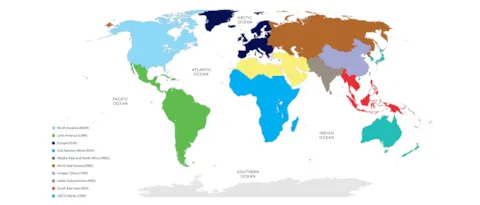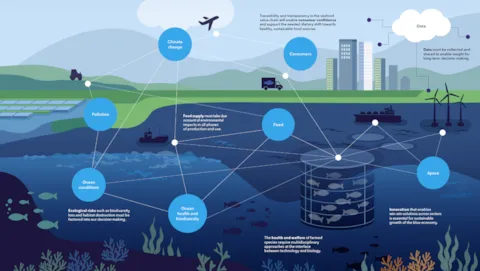Marine aquaculture: Setting the scene
With world population heading beyond nine billion by 2050, two billion more mouths will need secure sources of food that underpin healthy diets and can be sourced sustainably. Meeting all these criteria is an important objective within the ongoing Decade of Action for the UN Sustainable Development Goals (SDGs).
Covering 71% of the planet, the ocean could produce up to six times more food than today, according to the High Level Panel for a Sustainable Ocean Economy; but only if we manage both fisheries and marine aquaculture more sustainably.
Current status of global aquaculture production
Global aquaculture production was 114 million tonnes (live weight) in 2018. More than half (55%) came from four main species groups farmed in marine waters – finfish, crustaceans, molluscs, and seaweed.
Seaweed and molluscs contribute most in terms of weight, and China is by far the main producer. When considering protein content and market value, however, both marine finfish and crustaceans have more significant shares. These higher-value species groups are also more internationally traded than seaweed and molluscs, which are both largely used in local food-supply chains.
Our regional breakdown
Key socioeconomic drivers for our aquaculture analysis – for example, population and living standards – are derived for the 10 regions shown in the map. In our model, these regions are further divided by their proximity to the different ocean basins: Arctic, Atlantic, Indian, Pacific, and the Southern Ocean.
Our regions are also roughly consistent with those of the Organisation for Economic Co-operation and Development (OECD), namely Europe, North America, and OECD Pacific (Australia, Japan, South Korea, New Zealand). When presenting graphs in the report, we primarily show the regions of greatest relevance to our discussion and results.
Sustainable growth
The DNV Marine Aquaculture Forecast is positioned amidst a complex set of sustainability issues:
- Production of fish feed: Future production of food from aquaculture will be determined by the scalability of new ingredients.
- Environmental impacts of fed aquaculture: The aquaculture value chain from farming of raw materials to consumption of seafood leaves a significant environmental footprint. 90% of the environmental impact from fed aquaculture production has been traced to the fish feed.
- Space use in marine aquaculture: There is a need for marine spatial planning as an integrated approach for trading off the spatial requirements of competing ocean industries. Initiatives to co-locate marine aquaculture and offshore wind farms are a possible next step towards integrating several industries onto multipurpose platform.
- Biodiversity impacts: Including the risk of disease outbreaks which can also threaten coastal wildlife and wild fish species, intensive use of antibiotics, and fish escapes.
- Fish health and potential impacts from climate change: Throughout their life cycles, marine animals will encounter various health hazards, such as infectious diseases, changing environmental conditions, operational interventions, or system failures. Additionally, climate change towards 2050 will have an impact on ocean conditions and potentially worsen the situation.
- Transparency and traceability: Sustainable marine aquaculture production depends on transparency and traceability throughout the entire value chain, including feed, to prevent negative environmental and social impacts.
- Roles of policy and regulation: Global, regional, and national policies and mechanisms that encourage transparency, traceability, and sustainability in marine aquaculture must be put in place to accelerate these efforts.
Why has DNV published the Marine Aquaculture Forecast to 2050?
This forecast seeks to answer a question frequently put to us by customers: 'As things stand, what is the most likely long-term future for marine aquaculture?'
That is not easy to answer precisely. As a key provider of risk management and assurance services to the industry across its complete value chain, we are keenly aware that any projection must account for societal and technological trends. It must also factor in several risk factors, not least of which are ecological concerns.
We draw on our established role in assessing and qualifying new technologies to examine which could best enable the forecasted growth in marine aquaculture. Finfish production today is predominantly in sheltered coastal locations, for example, but has potential to meet demand sustainably because it can be land-based and in larger production units in more exposed and offshore locations. This allows it to address concerns such as fish health, pressure on inshore marine space, and environmental impacts.

